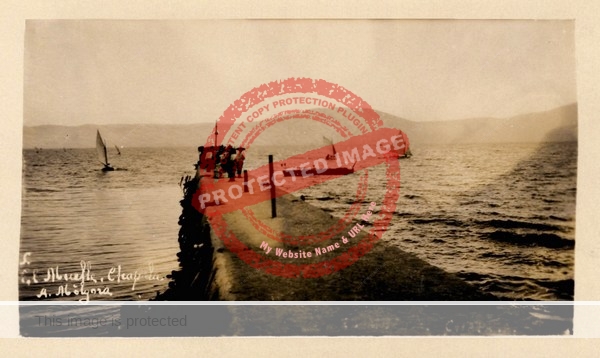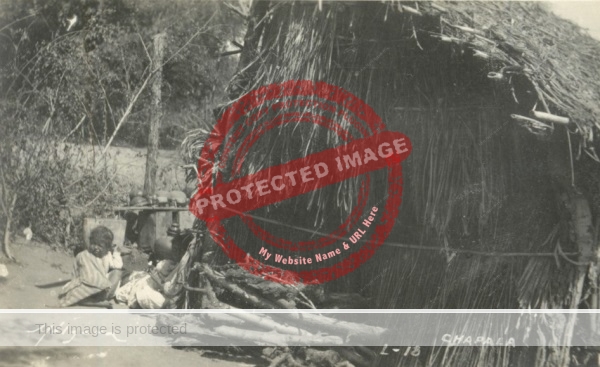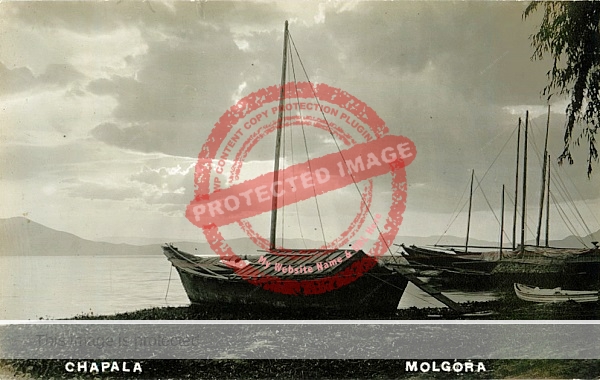Antonio Mólgora was an Italian businessman and hotelier who ran various hotels in Chapala from about 1907 to his death in 1927. Both he and one of his sons, also named Antonio, were accomplished amateur photographers and published a number of postcards, the son generally preferring pictures of boats and people to pictures of buildings. They were almost certainly the first local residents to produce real photographic postcards of Chapala.
At least three postcards—’El Muelle,’ ‘La Plalla’ [sic] and ‘La Reynera’—must be the work of Antonio Mólgora Sr., while many more can definitely be attributed to his son, Antonio Mólgora Jr. No evidence has surfaced that either of them ever tried to commercialize photographs of any other places; their Chapala postcards were presumably given or sold to visitors in the hotels owned or managed by Antonio Sr.
The numbering on some of Antonio Jr.’s postcards suggests there are likely to be many more photos of Chapala still waiting to be found and attributed to him!

Antonio Mólgora Sr. c. 1911. El Muelle.
Antonio Mólgora Sr.
Antonio Mólgora (Sr.) was born at Novara, Italy, in 1877. He was one of at least eight children born there to Clemente Mólgora Declerechi (1841-1900), a pork butcher, and his wife, Paulina de Ferrari (1852-1931). One of Antonio’s uncles, Enrique Mólgora (ca 1840-1900), had established himself and his family in Mexico in the 1870s, and Enrique’s brother—Antonio’s father—followed him to Mexico with his family in the 1890s.
In 1900, Antonio married 19-year-old María Espinosa Gómez in Chihuahua. The couple had two sons: Clemente Mólgora Espinosa (1901-1981) and Antonio Héctor Mólgora Espinosa (1903-1980). Clemente, who married a local Chapala girl in about 1927, is mentioned in Journey with Genius, the account by poet Witter Bynner of visiting Chapala in 1923 in the company of D. H. Lawrence. (Bynner later bought a house in the village and was a regular visitor for decades.)
It is unclear what Antonio Mólgora (father) did before becoming manager of the Gran Hotel Victor Huber in Chapala in about 1906. But, roughly three years later, he bought this hotel, originally named for its owner, and renamed it the Hotel Francés. (Located immediately opposite the church, it was demolished at the end of the 1940s when the wide main boulevard Avenida Francisco I. Madero was created.)
In 1919, Mólgora also took over the management of the Hotel Palmera. Part of this building, designed by Guillermo de Alba and completed in 1907, later became the Hotel Nido, and is now the Presidencia, housing Chapala municipal offices.
In March 1921 a vacationer wrote on a Mólgora postcard to friends in New Orleans that, besides having a good time, they had felt their first earthquake – “We all dressed and went down stairs. Thought the next shake would bring down the building.” a reference, presumably, to the 6.4 magnitude earthquake off the coast of Colima on 1 May 1921, an event fortunately without any casualties.
When D. H. Lawrence arrived in Chapala at the end of April 1923, there is evidence to suggest that the house he rented there on calle de los Pescadores (now calle Zaragoza) was owned by Antonio Sr.
Later that year Mólgora bought and took over the running of the Hotel Arzapalo, which he promptly renamed Hotel Mólgora. The Arzapalo had opened in 1898 as the town’s first major hotel, but had operated only intermittently during the Mexican Revolution before reopening in the 1920s.
Antonio Mólgora Sr., photographer, hotelier and ardent supporter of the Italian community in Guadalajara, died in his adopted home of Chapala on 9 October 1927.
Antonio Mólgora Jr.
Antonio Hector Mólgora (1903-1980) married in 1931 and had at least three children, including Jorge Enrique Mólgora Gil, an artist and architect who has designed or co-designed several projects in Chapala and Ajijic since the 1980s.
Antonio Hector Jr took numerous fine photographs of Chapala from about 1920 onward, at least 20 of which were published as postcards. His father promoted his hotels by offering special rates for excursion groups, and this photo of a passenger boat (below) may have been taken to document a special excursion group from Guadalajara.

Antonio Hector Mólgora. c. 1920? Villa Francia. (Familienarchiv Juan Nigg, Zürich.)
This lovely composition shows Villa Francia (Avenida Lourdes 14C / Mónaco 5), the hillside vacation home of Juan Nigg, the Swiss consul in Guadalajara in the 1910s and early 1920s. Nigg was on a Chapala improvement committee in December 1918, alongside Guillermo de Alba, Manuel Capetillo Villaseñor, José María Schnaider, Alfredo Levy, and various others. The town had given them 2,500 pesos to start work.
Antonio Mólgora Jr. also documented the huts used by fishermen at Chapala, including one on Isla de los Alacranes. It is unclear if this example (below) was taken on the island or somewhere closer to the town of Chapala:

Antonio Hector Mólgora. c. 1922? Fisherman’s hut, Lake Chapala.
This Mólgora postcard (with “MOLGORA” in block letters) of typical freight-carrying “sail canoes” or canoas (below) is evocative of the era in which D. H. Lawrence and his friends visited in 1923.

Antonio Hector Mólgora (probably). Date unknown. Boats on Lake Chapala.
Acknowledgment
My sincere thanks to Jorge Enrique Mólgora Gil for helping clarify which photographs were the work of his father, Antonio Hector Mólgora Espinosa, and to Philippe Welti, grandson of Juan Nigg, for permission to use the image of Villa Francia from his family archive.
My 2022 book Lake Chapala: A Postcard History uses reproductions of more than 150 vintage postcards to tell the incredible story of how Lake Chapala became an international tourist and retirement center.
Note: This post was first published 3 August 2019, with additions made in December 2023 and August 2025.
Sources:
- El Correo de Jalisco: 9 January 1907.
- El Informador: 15 September 1918, 2; 30 November 1919; 7 March 1920, 10; 1 July 1921, 7; 12 March 1926.
Comments, corrections and additional material are welcome, whether via the comments feature or email.
Tony Burton’s books include “Lake Chapala: A Postcard History” (2022), “Foreign Footprints in Ajijic” (2022), “If Walls Could Talk: Chapala’s historic buildings and their former occupants” (2020), (available in translation as “Si Las Paredes Hablaran”), “Mexican Kaleidoscope” (2016), and “Lake Chapala Through the Ages” (2008).
enjoyable read and photos–thanks